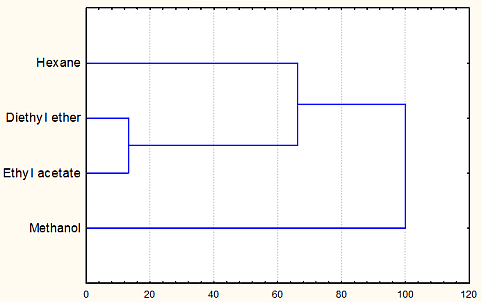
ANTIOXIDANT AND ANTIMICROBIAL ACTIVITIES OF THE ESSENTIAL OIL AND SOLVENT EXTRACTS OF MENTHA PULEGIUM L.
Abstract
We report the total phenolic (TPC; expressed as gallic acid equivalents, GAE, per milligram of dry extract weight) and the total flavonoid contents (TFC; expressed as quercetin equivalents, QE, per milligram of dry extract weight) and antimicrobial and antioxidant activities of the essential oil and hexane, diethyl ether, ethyl acetate and methanol extracts of Mentha pulegium L. (Lamiaceae) collected in Serbia. The total phenolic content was in the range of 129.43-388.29 μg GAE/mg, while TFC ranged from 57.81 to 160.94 QE/mg; the highest TPC and TFC were found in the methanol extract. The antimicrobial activity (against five bacteria and two fungi species) of the essential oil and solvent extracts was assessed using disc-diffusion method. However, the studied samples demonstrated a poor antimicrobial potential. The antioxidant activity was screened using five different tests: 2,2-diphenyl-1-picrylhydrazyl radical scavenging assay (DPPH), 2,2'-azino-bis(3-ethylbenzothiazoline-6-sulphonic acid radical cation decolorization assay (ABTS), total reducing power (TRP), ferric reducing antioxidant power (FRAP) and cupric reducing antioxidant capacity assay (CUPRAC); the methanol extract showed the strongest antioxidant potential. The results of the different antioxidant assays were correlated mutually and with the total flavonoid and total phenolic contents (regression analysis and agglomerative hierarchical clustering).
ANTIOKSIDANTNA I ANTIMIKROBNA AKTIVNOST ETARSKOG ULJA I EKSTRAKATA BILJNE VRSTE MENTHA PULEGIUM L.
U ovom radu je određen sadržaj ukupnih fenola (TPC; izražen u ekvivalentima galne kiseline, GAE, po miligramu suvog biljnog ekstrakta) i ukupnih flavonoida (TPC; izražen u ekvivalentima kvarcetina, QE, po miligramu suvog biljnog ekstrakta), kao i antimikrobna i antioksidantna aktivnost etarskog ulja i heksanskog, dietil-etarskog, etil-acetatnog i metanolnog ekstrakta biljne vrste Mentha pulegium L. (Lamiaceae; populacija iz Srbije). Sadržaj ukupnih fenola analiziranih uzoraka se kretao u opsegu od 129,43 do 388,29 μg GAE/mg, dok je TFC bio u interval od 57,81 do 160,94 QE/mg; najviše vrednosti za TPC i TFC nađene su za metanolni ekstrakt. Antimikrobna aktivnost (prema pet bakterijskih i dva soja gljivica) etarskog ulja i ekstrakata je određena disk-difuzionom metodom. Proučavani uzorci su imali slabu antimikrobnu aktivnost. Antioksidantna aktivnost je ispitivana pomoću DPPH (2,2-difenil-1-pikrilhidrazil radikal), ABTS (2,2'-azino-bis(3-etilbenzotijazolin-6-sulfonska kiselina radikal katjon), TRP (ukupna redukciona sposobnost), FRAP (sposobnost redukcije feri-jona) i CUPRAC (sposobnost redukcije Cu(II)-jona) metodama; najviši antioksidantni potencijal je imao metanolni ekstrakt. Rezultati različitih metoda za određivanje antioksidantnog potencijala su korelisani međusobno, kao i sa sadržajem ukupnih fenola i flavonoida (regresiona analiza i aglomerativna hijerarhijska klaster analiza).
HIGHLIGHTS
- The essential oil and hexane, diethyl ether, ethyl acetate and methanol extracts of Mentha pulegium L. collected in Serbia were studied.
- Their total phenolic content was in the range of 129.43-388.29 μg GAE/mg, while total flavonoid content ranged from 57.81 to 160.94 QE/mg.
- Solvent extracts (SE) and essential oil of the studied M. pulegium population were poor antimicrobials.
- Antioxidant activities of SE were studied using five different methods.
- Differences between the previous and the present results suggest M. pulegium metabolic profile might be influenced by both genetic and environmental factors.
Full Text:
PDFRefbacks
- There are currently no refbacks.
ISSN 0354-4656 (print)
ISSN 2406-0879 (online)